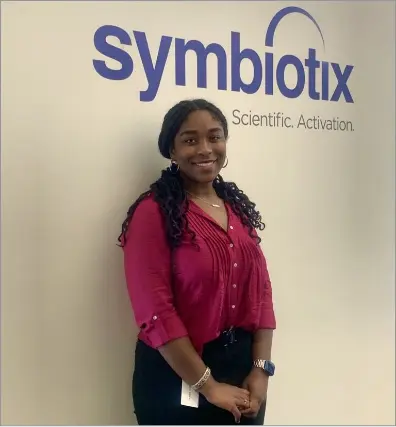Symbiotix Blog

Symbiotix Attends World Muscle Society Annual Congress
Symbiotix took to the road again this week for the World Muscle Society Annual Congress. It was…
Symbiotix took to the road again this week for the World Muscle Society Annual Congress. It was a great time discussing the latest in neuromuscular diseases, collaborating with the best and brightest in the space, and exploring how we can improve the patient experience. Check out how our team spent their time in charming Charleston!

September Symployee Spotlight: Sandra Lyle, PharmD
I learned about medical communications agencies during my last year of pharmacy school, and the…

Sandra Lyle, PharmD
Medical Writer
I learned about medical communications agencies during my last year of pharmacy school, and the most interesting aspect to me was that these agencies work with multiple pharmaceutical companies over a wide range of therapeutic areas. Working at Symbiotix has given me a chance to learn about a number of therapies for various disease states; it was through my experience here as a medical fellow that I discovered my passion for rare diseases. Aside from the research involved in my job, I’ve also had the pleasure of learning from some of the most intelligent, talented individuals across our clinical, editorial, creative, account, project management, and submissions teams. The brilliant minds at Symbiotix and the rapid evolution of medicine inspire me to continue spreading awareness for all of our brands and promoting education among HCPs and patients.

Symbiotix Welcomes Latest Group of Fellows
We are thrilled to be welcoming our newest fellows, Caleb, Linda, Shivani, and Lauren! We are…
We are thrilled to be welcoming our newest fellows, Caleb, Linda, Shivani, and Lauren! We are so happy to have you here at Symbiotix.




Symbiotix Attends World Muscle Society Annual Congress
Symbiotix took to the road again this week for the World Muscle Society Annual Congress. It was…

Even for seasoned medical communications professionals, both on marketing and medical affairs teams, omnichannel vs multichannel can be confusing to fully understand and differentiate. It doesn’t help that “omnichannel” is a digital buzzword that is often thrown around without truly defining or understanding. Symbiotix is here to help clarify and provide guidance.
Nearly all pharmaceutical companies are currently operating in a multichannel system at a minimum. The challenge is how to build and improve upon what they are currently doing to evolve into the next step—being omnichannel
Let’s start with the simpler concept of “multichannel.” Multichannel is exactly what it sounds like—using multiple channels to reach your audience. These can be—and typically are—a mix of both digital and traditional channels and could include tactics such as emails, text messaging, live in-person events, webinars, social media, and more. Multichannel typically uses siloed channels where the same general communication is shared on every channel. For example, let’s say a physician is browsing Medscape and sees a banner promoting an upcoming medical conference. She clicks and registers to attend. The next day, that same physician may be browsing on Twitter and see a sponsored post promoting the same conference—also asking her to register—even though she has already registered and is planning to attend. While it’s great that she saw conference content across multiple channels, her experience as a user was not optimal because she was being asked to register again despite already having done so via the banner ad on Medscape. A better experience (and spoiler alert: an omnichannel experience) may be Twitter content shown to “already registered” users asking for survey feedback on topics they may want to hear at the conference.
Unfortunately, omnichannel is an inherently confusing word. Despite the word literally meaning “all channels,” an omnichannel strategy does not mean using every possible channel option for engagement. Instead, omnichannel refers to the use of multiple channels in a connected, holistic, and continuous way. Omnichannel is less about the specific channels being used and more about the adaptation of experiences as users engage across channels.
We’ve all been browsing an ecommerce website, put an item in our cart, then left without purchasing—only to then be on Facebook or Twitter a few days later and see a retargeting ad for the item we left in our cart. This is a basic example of an omnichannel experience, where a user’s activity on one platform then prompts changes to how the user is targeted and engaged across other platforms. This level of interconnectedness between activities and channels that helps move users along a journey is a core concept of omnichannel and is simply not possible within a multichannel experience.
Both multichannel and omnichannel roll up into customer experience (CX), which is the overall experience your company provides to your audience. Every message, communication, campaign, and touchpoint will impact the way your audience feels about your company, and ultimately their decision of whether to engage with, advocate for, ignore, or actively disparage you. Generally, integrated omnichannel strategies will provide a smoother, easier, and more user-friendly experience than multichannel strategies, but only if done well.
An omnichannel ecosystem can range from relatively simple to highly complex. Naturally, the more complex the system, likely the better the CX, as a more complex system will encompass more touchpoints, more pivot points, and ultimately a more customized user experience based on data collected from previous engagements. The below graphic is an example of an integrated omnichannel HCP experience we recently designed and implemented for a pharma client.
This example started with defining custom HCP target segments and engaging them with customized content experiences based on email campaign engagements and activity across other digital channels, such as paid search, social media, and a medical education website. Ultimately, all this activity was captured and provided to an MSL to then engage the HCP in a customized and personalized way, completing the omnichannel experience.
Nearly all pharmaceutical companies are currently operating in a multichannel system at a minimum. The challenge is how to build and improve upon what they are currently doing to evolve into the next step—being omnichannel. It’s fair to say multichannel predates omnichannel, and true omnichannel is a more complex, precise, and customized endeavor than a traditional multichannel approach. Within all industries, many companies who claim to be executing in an omnichannel way are actually only still multichannel. In reality, omnichannel is multichannel with additional backend data integration and content customization overlaid on top of it.

September Symployee Spotlight: Sandra Lyle, Pharm
I learned about medical communications agencies during my last year of pharmacy school, and the…

The changing environment of the [past couple of] years has highlighted the role and importance of medical communications as a channel to drive optimal patient outcomes and build a better understanding of new drug therapies with clinical practitioners.
1. Health, Science, and Medicine: Top in Public Agenda
- COVID propelled a public interest in science and medicine
- Patient and public interest in medicines and drug choices have never been higher
- HCPs have to deal with more informed patients and often increased health literacy across sectors
2. Scientific Data and Clinical Evidence
- The volume of data, publications, and clinical information is increasing exponentially
- Drug and new treatment modalities rely on increasingly complex biologic pathways—and the science and data describing them equally become more complex
- HCPs need help in filtering the noise and prioritizing relevant information—identifying and translating what is important to their clinical practice
3. Omnichannel: HCPs Seek Information in Many Places
- HCPs shifted engagement, consuming more online/on-demand content
- Content must respect HCP time for engagement with careful use of content and channel
- Education has to recognize the multichannel engagement and ensure targeting, media relevance, and consistency of content
4. Expert Voices Make a Difference
- Digital opinion leaders may have reach and influence—however, medical experts have the real knowledge
- It’s now more critical than ever to ensure the right voice gets amplified
- Sources must be properly selected for clinical expertise and authority
- HCPs turn for clinical advice and to share knowledge with local/regional thought leaders in their community
5. Media and Place for the Conversation Is Changing Live and Virtual
- 2022 saw a rebound of live in-person engagement—the medical conference is back!
- At the same time virtual connections increased exponentially
- HCPs seek the live informed voice—but will seek it on their own time and terms. Hybrid, multichannel engagement is key
6. The HCP Learner Agenda Dominates
- HCPs have become more discerning in engagement with learning content
- Real and relevant clinical practice information must be delivered
- Interactivity and gamified content can be leveraged to meet learning styles of emerging healthcare learners
- Content must be targeted and structured to create breakthrough immersive experiences
7. The Patient Voice Is a Critical Element of Understanding
- The power of the real patient voice, expressing human needs is truly valued
- HCPs need to translate arid clinical data to become meaningful to their interaction with patients
8. HCPs Value Peer-to-Peer Interactions
- The number one thing that physicians and key opinion leaders (KOLs) say they miss about physical events is personal interaction
- HCPs want to have the authenticity of in-person interactions pulled through in online forums
- Peer-to-peer formats (live or online) should include smaller group discussion and bi-directional conversations

Symbiotix Welcomes Latest Group of Fellows
We are thrilled to be welcoming our newest fellows, Caleb, Linda, Shivani, and Lauren! We are…

The changing environment in 2021 accelerated HCP engagement with digital and social media. The pharmaceutical industry and the medical communication programs it provides need to recognize the rise in adoption of social media as a platform for communication and for delivery of data and clinical-related messaging. For HCPs, certain key needs are emerging. Attention to these in pharma-supported medical communications programs will elevate engagement and help ensure appropriate communications with the healthcare community, bounded by the compliance requirements that pharma communications live within.
Consider these 6 key emerging factors for success in social and digital media engagement:
Digital opinion leaders may have reach and influence—however, medical experts have the real knowledge. It’s critical that the right voice gets amplified and sources can be properly validated for clinical expertise and authority.
1. Validate Trusted Digital Sources
As educational and medical content become more commonplace in social media, the credibility and clinical authority of content need to be validated. As generalists and often self-appointed experts battle for social space, pharma must exercise caution as HCPs engage in increasingly detailed scientific and clinical interactive conversations on both public and private social media platforms. Ensuring valid and informed commentary as it affects medical advice is critical.
A significant opportunity in the social space is to engage allied and other HCPs in discussion and debate—socializing and crowd-amplifying qualified knowledge discussion. For pharma, mobilizing the knowledge and drug/disease expertise of nurse practitioners, nurses, physician assistants, and other professionals who, as critical members of the care team, are often spending the most time with patients and delivering an array of treatments and services, may be a powerful way to engage. The pharma medical science liaison (MSL) may provide a qualified point of informed and regulated content and information.
2. On Demand and Interactive Are the Way
Content needs to be built to ensure a seamless and integrated path of education, regardless of the moment or media of engagement-layered, linear learning journey, to allow physicians to step in and out, regardless of device or media preference. Gamification and virtual or artificial reality (VR/AR) platforms have evolved to become realistic options for engagement, and these technologies enable a creative pallet for illustrating disease processes and how medications may work. HCP digital natives expect brands to use these novel approaches to interact, educate, and engage them.

3. Closed Platforms Are Emerging
Peer-to-peer and gated qualified HCP-only communities all experienced significant membership and usage spikes because of the pandemic. Platforms such as Doximity, Sermo, Skipta, Figure 1, Medscape, and others capitalized on a need for clinical information and built new functionality to support practice and learning. This has established some of these as a valued one-stop platform in clinical practice allowing case sharing, diagnosis questions, and clinical advice alongside practical clinical tools. We anticipate continued efforts to increase HCP engagement and traffic, expand frequency of engagement, build longer educational sessions, augment content, and stimulate conversation and interaction within specialty newsfeeds.
Similarly, the pandemic prompted a spate of HCP group formation on virtually every platform. COVID-related clinical practice reviews, clinical society guideline evaluations, journal clubs, and even ad hoc/socialized diagnostic forums blossomed. HCPs sought connections and sharing opportunities with peers. Although some groups are open, others are cautiously private. Qualified and informed MSLs might transparently join relevant groups to understand and gauge the tone and direction of the conversations and to insert clinical or scientific information where and when appropriate.
4. Listening and Reading Are Still Popular
Consider the explosion of podcasts and the instant popularity of Google Clubhouse, and you will recognize there is a place for the spoken word in pharma NPP. Podcasts prepared or led by HCPs or medical institutions increased 40% in 2021 over 2020. Audio tracks featuring key opinion leaders (KOLs) and panel discussions can be recorded and posted on websites, educational media, and social media pages. These are popular as a portable resource for education regardless of venue. Additionally, audio-supported animated ads on digital and social media are becoming a differentiator. Consider changing SEO tactics to align with the steady growth of live or recorded audio search. Under a similar thought, closed captions and text support of the spoken word have proven to be a powerful reinforcement of content.
5. Be Connected for Greater Value
The more complex the disease, the more complex the patient paperwork and adherence challenges. Beyond diagnosis and treatment, patients turn to their HCPs for educational materials, coverage and access advice, co-pay cards, samples, medication dosing and adherence information, and dedicated customer service resources. Pharma marketers are expanding these tool sets, and HCPs are eager to obtain and distribute them. Two-thirds of HCPs indicate they use patient education materials when provided to them. Look for expansion in the number of services offered and the number of pharma brands offering patient support.
Likewise, think beyond the MD for all connections in the practice who engage with patients and who have differing needs: Nurse practitioners, nurses, physician assistants, medical assistants, and practice managers are critical members of the care team, often spending significant time with patients and delivering an array of treatments and services. Often active in social media, they are chronically underserved by pharma marketers who tend to focus time and attention on physicians. The best communications will embrace these populations, carve out budget to reach and persuade them, and dedicate resources to educate and engage them.

6. Amplify Customer Engagement
Replacing incidental connections with sustained interactions will require a different content and contact strategy delivered through a mix of channels. Look for electronic health records and ePrescribing vendors to tout their advanced analytics capabilities to predict and transmit the right message to the right patient or HCP at the right moment for optimal impact. Gaining access to the right data and finessing privacy protocols will make or break these claims. Consider too the impact of wearable and mobile personal monitoring. Google, Apple, and Epic (Fitbit, Apple Watch, and MyChart, respectively) are leading the way in building mobile monitoring technologies that collect and traffic real-time health data. Their long-term goal is to improve care, react to individual metabolic changes, drive adherence, educate patients, centralize and synchronize medical records, and predict or anticipate health incidents or needed treatments or procedures. Predictive targeting of patients and disease or content need will become the new mantra. Imagine the behavior and workflow changes necessary for HCPs when they are confronted with real-time data streams from multiple patients who expect quick, expert reading and reactions. The practical value of these technologies has potential beyond anything we’ve seen to date.
Symbiotix took to the road again this week for the World Muscle Society Annual Congress. It was a great time discussing the latest in neuromuscular diseases, collaborating with the best and brightest in the space, and exploring how we can improve the patient experience. Check out how our team spent their time in charming Charleston!

Sandra Lyle, PharmD
Medical Writer
I learned about medical communications agencies during my last year of pharmacy school, and the most interesting aspect to me was that these agencies work with multiple pharmaceutical companies over a wide range of therapeutic areas. Working at Symbiotix has given me a chance to learn about a number of therapies for various disease states; it was through my experience here as a medical fellow that I discovered my passion for rare diseases. Aside from the research involved in my job, I’ve also had the pleasure of learning from some of the most intelligent, talented individuals across our clinical, editorial, creative, account, project management, and submissions teams. The brilliant minds at Symbiotix and the rapid evolution of medicine inspire me to continue spreading awareness for all of our brands and promoting education among HCPs and patients.
We are thrilled to be welcoming our newest fellows, Caleb, Linda, Shivani, and Lauren! We are so happy to have you here at Symbiotix.




Even for seasoned medical communications professionals, both on marketing and medical affairs teams, omnichannel vs multichannel can be confusing to fully understand and differentiate. It doesn’t help that “omnichannel” is a digital buzzword that is often thrown around without truly defining or understanding. Symbiotix is here to help clarify and provide guidance.
Nearly all pharmaceutical companies are currently operating in a multichannel system at a minimum. The challenge is how to build and improve upon what they are currently doing to evolve into the next step—being omnichannel
Let’s start with the simpler concept of “multichannel.” Multichannel is exactly what it sounds like—using multiple channels to reach your audience. These can be—and typically are—a mix of both digital and traditional channels and could include tactics such as emails, text messaging, live in-person events, webinars, social media, and more. Multichannel typically uses siloed channels where the same general communication is shared on every channel. For example, let’s say a physician is browsing Medscape and sees a banner promoting an upcoming medical conference. She clicks and registers to attend. The next day, that same physician may be browsing on Twitter and see a sponsored post promoting the same conference—also asking her to register—even though she has already registered and is planning to attend. While it’s great that she saw conference content across multiple channels, her experience as a user was not optimal because she was being asked to register again despite already having done so via the banner ad on Medscape. A better experience (and spoiler alert: an omnichannel experience) may be Twitter content shown to “already registered” users asking for survey feedback on topics they may want to hear at the conference.
Unfortunately, omnichannel is an inherently confusing word. Despite the word literally meaning “all channels,” an omnichannel strategy does not mean using every possible channel option for engagement. Instead, omnichannel refers to the use of multiple channels in a connected, holistic, and continuous way. Omnichannel is less about the specific channels being used and more about the adaptation of experiences as users engage across channels.
We’ve all been browsing an ecommerce website, put an item in our cart, then left without purchasing—only to then be on Facebook or Twitter a few days later and see a retargeting ad for the item we left in our cart. This is a basic example of an omnichannel experience, where a user’s activity on one platform then prompts changes to how the user is targeted and engaged across other platforms. This level of interconnectedness between activities and channels that helps move users along a journey is a core concept of omnichannel and is simply not possible within a multichannel experience.
Both multichannel and omnichannel roll up into customer experience (CX), which is the overall experience your company provides to your audience. Every message, communication, campaign, and touchpoint will impact the way your audience feels about your company, and ultimately their decision of whether to engage with, advocate for, ignore, or actively disparage you. Generally, integrated omnichannel strategies will provide a smoother, easier, and more user-friendly experience than multichannel strategies, but only if done well.
An omnichannel ecosystem can range from relatively simple to highly complex. Naturally, the more complex the system, likely the better the CX, as a more complex system will encompass more touchpoints, more pivot points, and ultimately a more customized user experience based on data collected from previous engagements. The below graphic is an example of an integrated omnichannel HCP experience we recently designed and implemented for a pharma client.
This example started with defining custom HCP target segments and engaging them with customized content experiences based on email campaign engagements and activity across other digital channels, such as paid search, social media, and a medical education website. Ultimately, all this activity was captured and provided to an MSL to then engage the HCP in a customized and personalized way, completing the omnichannel experience.
Nearly all pharmaceutical companies are currently operating in a multichannel system at a minimum. The challenge is how to build and improve upon what they are currently doing to evolve into the next step—being omnichannel. It’s fair to say multichannel predates omnichannel, and true omnichannel is a more complex, precise, and customized endeavor than a traditional multichannel approach. Within all industries, many companies who claim to be executing in an omnichannel way are actually only still multichannel. In reality, omnichannel is multichannel with additional backend data integration and content customization overlaid on top of it.

The changing environment of the [past couple of] years has highlighted the role and importance of medical communications as a channel to drive optimal patient outcomes and build a better understanding of new drug therapies with clinical practitioners.
1. Health, Science, and Medicine: Top in Public Agenda
- COVID propelled a public interest in science and medicine
- Patient and public interest in medicines and drug choices have never been higher
- HCPs have to deal with more informed patients and often increased health literacy across sectors
The changing environment of the [past couple of] years has highlighted the role and importance of medical communications as a channel to drive optimal patient outcomes and build a better understanding of new drug therapies with clinical practitioners.
2. Scientific Data and Clinical Evidence
- The volume of data, publications, and clinical information is increasing exponentially
- Drug and new treatment modalities rely on increasingly complex biologic pathways—and the science and data describing them equally become more complex
- HCPs need help in filtering the noise and prioritizing relevant information—identifying and translating what is important to their clinical practice
3. Omnichannel: HCPs Seek Information in Many Places
- HCPs shifted engagement, consuming more online/on-demand content
- Content must respect HCP time for engagement with careful use of content and channel
- Education has to recognize the multichannel engagement and ensure targeting, media relevance, and consistency of content
4. Expert Voices Make a Difference
- Digital opinion leaders may have reach and influence—however, medical experts have the real knowledge
- It’s now more critical than ever to ensure the right voice gets amplified
- Sources must be properly selected for clinical expertise and authority
- HCPs turn for clinical advice and to share knowledge with local/regional thought leaders in their community
5. Media and Place for the Conversation Is Changing Live and Virtual
- 2022 saw a rebound of live in-person engagement—the medical conference is back!
- At the same time virtual connections increased exponentially
- HCPs seek the live informed voice—but will seek it on their own time and terms. Hybrid, multichannel engagement is key
6. The HCP Learner Agenda Dominates
- HCPs have become more discerning in engagement with learning content
- Real and relevant clinical practice information must be delivered
- Interactivity and gamified content can be leveraged to meet learning styles of emerging healthcare learners
- Content must be targeted and structured to create breakthrough immersive experiences
7. The Patient Voice Is a Critical Element of Understanding
- The power of the real patient voice, expressing human needs is truly valued
- HCPs need to translate arid clinical data to become meaningful to their interaction with patients
8. HCPs Value Peer-to-Peer Interactions
- The number one thing that physicians and key opinion leaders (KOLs) say they miss about physical events is personal interaction
- HCPs want to have the authenticity of in-person interactions pulled through in online forums
- Peer-to-peer formats (live or online) should include smaller group discussion and bi-directional conversations

The changing environment in 2021 accelerated HCP engagement with digital and social media. The pharmaceutical industry and the medical communication programs it provides need to recognize the rise in adoption of social media as a platform for communication and for delivery of data and clinical-related messaging. For HCPs, certain key needs are emerging. Attention to these in pharma-supported medical communications programs will elevate engagement and help ensure appropriate communications with the healthcare community, bounded by the compliance requirements that pharma communications live within.
Consider these 6 key emerging factors for success in social and digital media engagement:
Digital opinion leaders may have reach and influence—however, medical experts have the real knowledge. It’s critical that the right voice gets amplified and sources can be properly validated for clinical expertise and authority.
1. Validate Trusted Digital Sources
As educational and medical content become more commonplace in social media, the credibility and clinical authority of content need to be validated. As generalists and often self-appointed experts battle for social space, pharma must exercise caution as HCPs engage in increasingly detailed scientific and clinical interactive conversations on both public and private social media platforms. Ensuring valid and informed commentary as it affects medical advice is critical.
A significant opportunity in the social space is to engage allied and other HCPs in discussion and debate—socializing and crowd-amplifying qualified knowledge discussion. For pharma, mobilizing the knowledge and drug/disease expertise of nurse practitioners, nurses, physician assistants, and other professionals who, as critical members of the care team, are often spending the most time with patients and delivering an array of treatments and services, may be a powerful way to engage. The pharma medical science liaison (MSL) may provide a qualified point of informed and regulated content and information.
2. On Demand and Interactive Are the Way
Content needs to be built to ensure a seamless and integrated path of education, regardless of the moment or media of engagement-layered, linear learning journey, to allow physicians to step in and out, regardless of device or media preference. Gamification and virtual or artificial reality (VR/AR) platforms have evolved to become realistic options for engagement, and these technologies enable a creative pallet for illustrating disease processes and how medications may work. HCP digital natives expect brands to use these novel approaches to interact, educate, and engage them.

3. Closed Platforms Are Emerging
Peer-to-peer and gated qualified HCP-only communities all experienced significant membership and usage spikes because of the pandemic. Platforms such as Doximity, Sermo, Skipta, Figure 1, Medscape, and others capitalized on a need for clinical information and built new functionality to support practice and learning. This has established some of these as a valued one-stop platform in clinical practice allowing case sharing, diagnosis questions, and clinical advice alongside practical clinical tools. We anticipate continued efforts to increase HCP engagement and traffic, expand frequency of engagement, build longer educational sessions, augment content, and stimulate conversation and interaction within specialty newsfeeds.
Similarly, the pandemic prompted a spate of HCP group formation on virtually every platform. COVID-related clinical practice reviews, clinical society guideline evaluations, journal clubs, and even ad hoc/socialized diagnostic forums blossomed. HCPs sought connections and sharing opportunities with peers. Although some groups are open, others are cautiously private. Qualified and informed MSLs might transparently join relevant groups to understand and gauge the tone and direction of the conversations and to insert clinical or scientific information where and when appropriate.
4. Listening and Reading Are Still Popular
Consider the explosion of podcasts and the instant popularity of Google Clubhouse, and you will recognize there is a place for the spoken word in pharma NPP. Podcasts prepared or led by HCPs or medical institutions increased 40% in 2021 over 2020. Audio tracks featuring key opinion leaders (KOLs) and panel discussions can be recorded and posted on websites, educational media, and social media pages. These are popular as a portable resource for education regardless of venue. Additionally, audio-supported animated ads on digital and social media are becoming a differentiator. Consider changing SEO tactics to align with the steady growth of live or recorded audio search. Under a similar thought, closed captions and text support of the spoken word have proven to be a powerful reinforcement of content.
5. Be Connected for Greater Value
The more complex the disease, the more complex the patient paperwork and adherence challenges. Beyond diagnosis and treatment, patients turn to their HCPs for educational materials, coverage and access advice, co-pay cards, samples, medication dosing and adherence information, and dedicated customer service resources. Pharma marketers are expanding these tool sets, and HCPs are eager to obtain and distribute them. Two-thirds of HCPs indicate they use patient education materials when provided to them. Look for expansion in the number of services offered and the number of pharma brands offering patient support.
Likewise, think beyond the MD for all connections in the practice who engage with patients and who have differing needs: Nurse practitioners, nurses, physician assistants, medical assistants, and practice managers are critical members of the care team, often spending significant time with patients and delivering an array of treatments and services. Often active in social media, they are chronically underserved by pharma marketers who tend to focus time and attention on physicians. The best communications will embrace these populations, carve out budget to reach and persuade them, and dedicate resources to educate and engage them.

6. Amplify Customer Engagement
Replacing incidental connections with sustained interactions will require a different content and contact strategy delivered through a mix of channels. Look for electronic health records and ePrescribing vendors to tout their advanced analytics capabilities to predict and transmit the right message to the right patient or HCP at the right moment for optimal impact. Gaining access to the right data and finessing privacy protocols will make or break these claims. Consider too the impact of wearable and mobile personal monitoring. Google, Apple, and Epic (Fitbit, Apple Watch, and MyChart, respectively) are leading the way in building mobile monitoring technologies that collect and traffic real-time health data. Their long-term goal is to improve care, react to individual metabolic changes, drive adherence, educate patients, centralize and synchronize medical records, and predict or anticipate health incidents or needed treatments or procedures. Predictive targeting of patients and disease or content need will become the new mantra. Imagine the behavior and workflow changes necessary for HCPs when they are confronted with real-time data streams from multiple patients who expect quick, expert reading and reactions. The practical value of these technologies has potential beyond anything we’ve seen to date.
